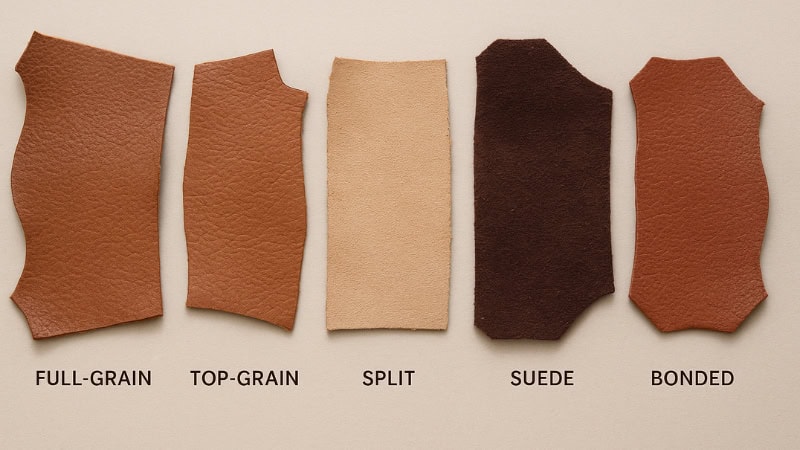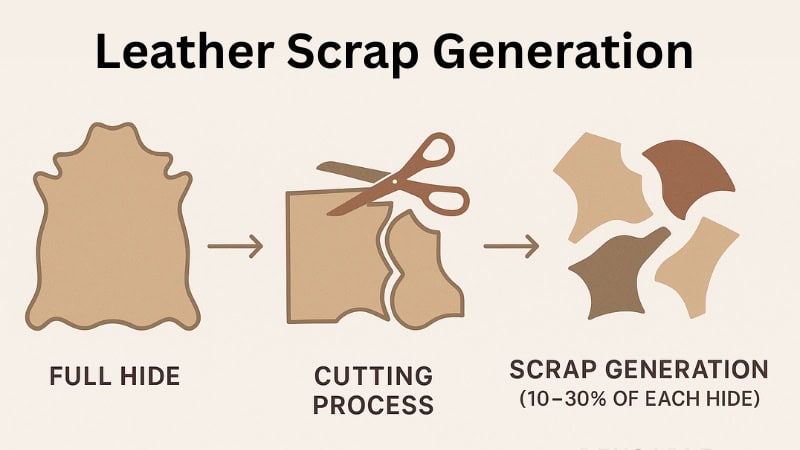In every tannery, workshop, and atelier where leather is shaped into luxury goods, countless small pieces fall away — curved corners from bag panels, thin trimmings from upholstery, or oddly shaped fragments from shoe production. These pieces, too small to form part of the final product, are known as leather scraps or scrap leather.
For decades, these remnants were seen as manufacturing waste. But as sustainability becomes a defining force across global industries, leather scraps have begun a quiet revolution. They are being reclaimed, repurposed, and reimagined — turning what was once discarded into a cornerstone of eco-conscious production.
In this in-depth guide, we’ll explore what leather scrap truly is, how it’s created, where it’s used, and why it’s gaining such importance in modern fashion, crafts, and manufacturing.
What Is Leather Scrap?
Leather scrap refers to the leftover pieces of genuine leather produced during the cutting and shaping of larger hides. These remnants can vary greatly in size, texture, color, and type, depending on the original leather and its intended product.
How Leather Scraps Are Created
When manufacturers cut leather hides for products like bags, shoes, belts, or upholstery, they aim to maximize efficiency. However, natural hides are irregularly shaped — unlike synthetic materials that come in uniform sheets. As a result, even the most efficient cutting process leaves behind 10–30% of unused leather.
These offcuts become leather scraps. While some are small trimmings, others can be large enough for crafting or repair work. Their potential depends on their grade and quality, often matching that of the original full-grain or top-grain hide.
Recommended Read: How Can You Tell Real Leather from Fake? – The Ultimate Guide
Types of Leather Scraps
Leather scraps come in many forms, often categorized by the layer of the hide or finishing process:
- Full-Grain Scraps: High-quality remnants from premium leathers — durable, natural surface, visible grain.
- Top-Grain Scraps: Smooth and flexible pieces often from luxury goods.
- Split Leather Scraps: Thinner, suede-like pieces from lower layers of the hide.
- Suede Scraps: Soft-textured, fuzzy finish from the underside of the hide.
- Bonded Leather Scraps: Shredded leather fibers combined with binders to form a reconstituted material.
Each type serves a unique purpose — from fine crafting to industrial applications — ensuring almost no piece of leather truly goes to waste.
Economic and Environmental Importance of Leather Scrap
Leather scraps carry both economic and ecological significance. In an era of sustainability-driven production, they are a vital resource for minimizing waste and maximizing value.
1. Reducing Waste in Leather Production
The leather industry, historically criticized for waste generation, now sees scraps as part of a circular economy. Instead of ending up in landfills, scraps are sorted, cleaned, and reused. Some tanneries have developed systems to reintegrate scraps into bonded leather sheets, reducing material waste by up to 90%.
2. Cost-Efficient Resource for Artisans and Small Businesses
Leather scraps offer an affordable gateway for small-scale makers and designers who can’t source full hides due to high costs. This accessibility democratizes craftsmanship — enabling more people to create genuine leather products sustainably and economically.
3. Environmental Benefits
Repurposing leather scraps contributes to resource conservation. By reusing existing materials, the industry reduces demand for new hides, which lowers the carbon footprint associated with tanning and transport.
In short, each reused scrap equals one less hide tanned, one less waste pile burned or buried, and one more step toward responsible manufacturing.
How the Leather Industry Uses Scraps
Leather scraps aren’t just a byproduct — they’ve evolved into a valuable raw material for multiple sectors. Let’s look at how they’re transforming industries.
1. Fashion and Accessories
Designers are increasingly turning to leather scraps for small accessories and statement pieces.
Common uses include:
- Wallets, coin purses, and keychains
- Patchwork handbags and belts
- Leather jewelry and wristbands
- Custom footwear detailing
The upcycled aesthetic has become trendy, representing craftsmanship and conscious consumption — two ideals modern consumers value deeply.
2. Furniture and Upholstery
Furniture makers often use leather scraps for:
- Repair patches and reinforcements
- Decorative stitching or contrasting panels
- Leather cushions and wall décor
Some high-end brands even craft mosaic or quilted leather panels using small pieces, turning functional waste into artful design.
3. Automotive Interiors
In the automotive industry, precision matters. Large leather panels are used for seats, while smaller scraps serve in:
- Steering wheel covers
- Gear knob sheaths
- Door panel reinforcements
Luxury automakers have also begun experimenting with bonded leather, made partially from reclaimed scraps, as an eco-friendly alternative.
4. Industrial Recycling and Bonded Leather
When scraps are too small for direct use, they can be shredded and mixed with natural binders to create bonded leather sheets. These sheets are then used for:
- Bookbinding covers
- Office furniture
- Packaging
- Fashion accessories
Bonded leather maximizes resource efficiency while preserving the feel of real leather — a true win for sustainability.
The Rise of Upcycling and the Maker Movement
In recent years, a global movement of artisans, crafters, and eco-conscious consumers has breathed new life into leather scraps. This “maker culture” values creativity, authenticity, and sustainability — and leather scraps perfectly embody these ideals.
-
Empowering Small Creators
Platforms like Etsy, Pinterest, and Instagram have become hotspots for independent makers who transform scraps into beautiful products. From minimalist wallets to intricate patchwork jackets, these creations tell a story of ingenuity and resourcefulness.
-
Redefining Beauty in Imperfection
Scrap leather pieces often carry irregularities — variations in color, texture, or grain. Instead of flaws, these are celebrated as marks of authenticity, making each handcrafted piece one-of-a-kind.
-
Sourcing Leather Scraps
Artisans typically source scraps from:
- Local tanneries and leather factories
- Online marketplaces (Etsy, eBay, Tandy Leather)
- Upcycling programs by fashion houses
Some tanneries even offer “scrap bundles,” pre-sorted by color and thickness for crafters.
Leather Scrap vs. Faux Leather: Understanding the Difference
Many people confuse leather scraps with synthetic (faux) leather. The difference lies in origin, sustainability, and longevity.
| Feature | Leather Scrap | Faux Leather (PU/PVC) |
| Material Origin | Genuine animal hide remnants | Synthetic petroleum-based plastic |
| Durability | Ages well, long-lasting | Prone to cracking and peeling |
| Environmental Impact | Reuses natural material, biodegradable | Non-biodegradable, emits toxins when produced |
| Feel and Patina | Natural texture, develops patina | Artificial uniform surface |
| Sustainability Value | High — part of a circular economy | Low — dependent on fossil fuels |
In short, real leather scraps are a sustainable choice that upcycle existing materials, whereas faux leather is often marketed as “vegan” but may cause greater environmental harm.
Challenges in Using Leather Scrap
Despite its potential, working with leather scraps comes with challenges.
- Inconsistent Sizes and Shapes: Scraps are irregular — which means pattern-making and cutting require creativity. Large-scale uniform production can be difficult.
- Sorting and Grading: Scraps vary in thickness, finish, and color. Proper sorting and grading are time-consuming but essential for quality results.
- Limited Recycling Infrastructure: While bonded leather processes exist, few facilities handle small-scale leather recycling. Expanding these operations remains a key sustainability goal for the industry.
Recommended Read: Key Innovations Meant for Sustainable Leather Industry
Innovation and Technology in Leather Scrap Utilization
The future of leather scrap management is bright — powered by innovation.
- Digital Cutting Technology: Modern leather cutting systems use AI and 3D pattern mapping to optimize hide utilization, reducing waste by up to 20%. This precision minimizes scrap generation at the source.
- Bio-Based Adhesives and Binders: Companies are replacing synthetic glues with plant-based binders to produce more eco-friendly bonded leather sheets.
- Startups and Sustainable Brands: Innovative brands like Elvis & Kresse, Lefrik, and Upcycled Leather Co. specialize in repurposing leather scraps from luxury houses into premium accessories — proving that waste can be redefined as luxury.
How to Start Using Leather Scrap: A Guide for Creators and Businesses
Leather scraps open endless possibilities for creators, brands, and artisans. With the right selection, tools, and ideas, these remnants can become practical, profitable, and sustainable materials for design and production.
-
Choosing the Right Type of Leather Scrap
Pick your scraps based on purpose. Full-grain and top-grain pieces are strong and ideal for wallets, belts, or small goods. Split leather and suede scraps are thinner and flexible — great for upholstery or patchwork designs. If you need consistency and scale, bonded leather made from reconstituted scraps offers a sustainable option for packaging or book covers. Match the leather type to your project’s durability and texture needs.
Recommended Read: The Ultimate Leatherworking Tools List for Everyone
-
Tools You’ll Need for Working with Leather Scraps
A few essential tools go a long way. Use a rotary cutter or utility knife for clean cuts and a cutting mat for safety. A punch set, stitching awl, and waxed thread help achieve neat seams. Finish edges with a beveler and burnisher, and apply a leather conditioner to keep the surface supple. For businesses, industrial sewing machines or laser cutters can scale production while maintaining precision.
Recommended Read: How to Stamp on Leather: The Complete Beginner’s Guide
-
Creative Ideas and Projects with Leather Scraps
Start small with keychains, coasters, or bookmarks to practice cutting and stitching. Combine scraps for patchwork bags, journals, or belts that celebrate unique textures and tones. Businesses can use larger scraps for branding tags, packaging straps, or furniture accents to add a sustainable touch. Each piece you create not only reduces waste but also tells a story of thoughtful craftsmanship.
Future of Leather Scrap in Sustainable Design
As the fashion and furniture industries shift toward eco-conscious production, leather scraps are gaining newfound respect. The next frontier lies in integrating these remnants into large-scale manufacturing — not as a compromise, but as a design choice.
Expect to see:
- Closed-loop leather production models, where waste is continuously reused.
- Collaborations between tanneries and sustainable brands.
- Educational initiatives encouraging young designers to view scraps as assets, not waste.
The humble leather scrap is fast becoming a symbol of responsible craftsmanship, bridging tradition with modern innovation.
Conclusion: From Waste to Worth
Leather scraps once symbolized inefficiency. Today, they represent the future of sustainability in the leather world. Every small offcut — whether stitched into a handmade wallet or compressed into a new bonded sheet — tells a story of transformation, responsibility, and creativity.
The leather industry’s journey toward sustainability is ongoing, and leather scraps are at its heart. They remind us that value isn’t always found in what’s perfect — sometimes, it lies in what we choose not to waste.




